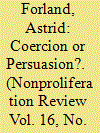| Srl | Item |
| 1 |
ID:
087044


|
|
|
|
|
| Publication |
2009.
|
| Summary/Abstract |
From 1961 to 1963, an interagency debate took place within the Kennedy administration as to whether to use persuasion or more coercive means in order to multilateralize nuclear safeguards, that is, to make the International Atomic Energy Agency (IAEA) the administrator of safeguards on bilateral nuclear exports from the United States. Persuasion as a general rule was deemed preferable, in order to make the many states that had misgivings about IAEA safeguards accept multilateralization. The coercion-persuasion debate followed years of trying to establish a "common front" among Western nuclear suppliers with regard to nuclear safeguards. Disagreement about the intrusiveness of the system proved a major obstacle, but eventually a common position reflecting the need to take international opinion into consideration was agreed. The adoption of the first IAEA safeguards document in 1961 created for the first time a common standard for the application of safeguards. This was a prerequisite to the U.S. policy of transferring to the IAEA the administration of safeguards on bilateral nuclear agreements. The resulting multilateralization of safeguards laid the groundwork for the IAEA to become the universal safeguarder in connection with the Treaty on the Non-Proliferation of Nuclear Weapons-an unforeseen outcome, since at the outset, IAEA safeguards were perceived as a "holding operation" while waiting for a disarmament agreement.
|
|
|
|
|
|
|
|
|
|
|
|
|
|
|
|
| 2 |
ID:
087043


|
|
|
|
|
| Publication |
2009.
|
| Summary/Abstract |
Indonesia, Thailand, and Vietnam recently announced that they are launching nuclear energy programs, and Malaysia and the Philippines soon may follow suit. As a result, by 2020, at least three states in Southeast Asia could possess latent nuclear capabilities-the option to pursue military applications of dual-use nuclear technology. Analysis of the nuclear programs, domestic proliferation pressures, and the external threat environment in Southeast Asia leads the authors to conclude that the nuclear intentions of states in that region are entirely peaceful and the probability of future nuclear breakout there is low. However, this finding does not justify complacency. In the long term, the benign outlook for regional security may change, and in the near term weak regulatory regimes present serious challenges to nuclear safety and create opportunities that non-state actors may exploit. To minimize these risks, the authors recommend creating a "proliferation firewall" around the region, which would combine strong global support for Southeast Asian nuclear energy programs with innovative regional multilateral nuclear arrangements.
|
|
|
|
|
|
|
|
|
|
|
|
|
|
|
|